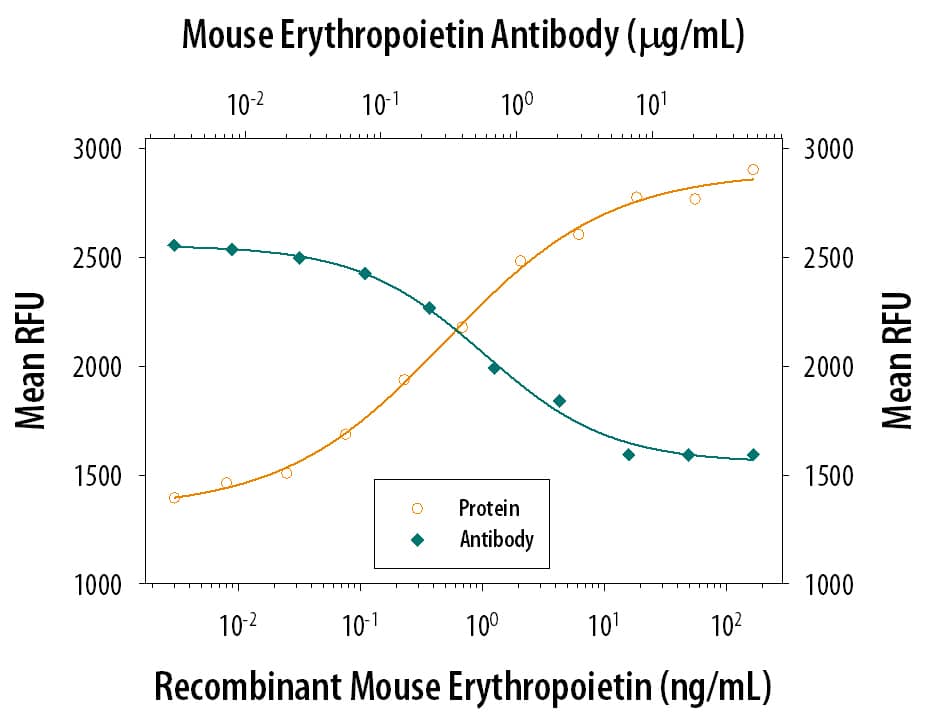Mouse Erythropoietin/EPO Antibody
R&D Systems, part of Bio-Techne | Catalog # MAB9591

Key Product Details
Species Reactivity
Validated:
Cited:
Applications
Validated:
Cited:
Label
Antibody Source
Product Specifications
Immunogen
Ala27-Arg192
Accession # P07321
Specificity
Clonality
Host
Isotype
Endotoxin Level
Scientific Data Images for Mouse Erythropoietin/EPO Antibody
Cell Proliferation Induced by Erythropoietin/EPO and Neutralization by Mouse Erythropoietin Antibody.
Recombinant Mouse Erythropoietin/EPO (Catalog # 959-ME) stimulates proliferation in the TF-1 human erythro-leukemic cell line in a dose-dependent manner (orange line). Proliferation elicited by Recom-binant Mouse Erythropoietin/EPO (10 ng/mL) is neutralized (green line) by increasing concen-trations of Rat Anti-Mouse Erythropoietin/EPO Monoclonal Antibody (Catalog # MAB9591). The ND50 is typically 0.15-0.75 µg/mL.Applications for Mouse Erythropoietin/EPO Antibody
Neutralization
Mouse Erythropoietin/EPO Sandwich Immunoassay
Reviewed Applications
Read 2 reviews rated 5 using MAB9591 in the following applications:
Formulation, Preparation, and Storage
Purification
Reconstitution
Formulation
Shipping
Stability & Storage
- 12 months from date of receipt, -20 to -70 °C as supplied.
- 1 month, 2 to 8 °C under sterile conditions after reconstitution.
- 6 months, -20 to -70 °C under sterile conditions after reconstitution.
Background: Erythropoietin/EPO
Erythropoietin (EPO) is a 34 kDa glycoprotein hormone in the type I cytokine family and is related to thrombopoietin (1). Its three N‑glycosylation sites, four alpha helices, and N- to C-terminal disulfide bond are conserved across species (2, 3). Glycosylation of EPO is required for biological activities in vivo (4). Mature mouse EPO shares 95% amino acid sequence identity with rat EPO and 73%‑82% with bovine, canine, equine, feline, human, ovine, and porcine EPO. EPO is primarily produced in the kidney by a population of fibroblast-like cortical interstitial cells adjacent to the proximal tubules (5). It is also produced in much lower, but functionally significant amounts by fetal hepatocytes and in adult liver and brain (6‑8). EPO promotes erythrocyte formation by preventing the apoptosis of early erythroid precursors which express the EPO receptor (EPO R) (8, 9). EPO R has also been described in brain, retina, heart, skeletal muscle, kidney, endothelial cells, and a variety of tumor cells (7, 8, 10, 11). Ligand induced dimerization of EPO R triggers JAK2-mediated signaling pathways followed by receptor/ligand endocytosis and degradation (1, 12). Rapid regulation of circulating EPO allows tight control of erythrocyte production and hemoglobin concentrations. Anemia or other causes of low tissue oxygen tension induce EPO production by stabilizing the hypoxia-induceable transcription factors HIF-1 alpha and HIF-2 alpha (1, 6). EPO additionally plays a tissue‑protective role in ischemia by blocking apoptosis and inducing angiogenesis (7, 8, 13).
References
- Koury, M. J. (2005) Exp. Hematol. 33:1263.
- Shoemaker, C.B. and L.D. Mitsock (1986) Mol. Cell. Biol 6:849.
- Wen, D. et al. (1993) Blood 82:1507.
- Tsuda E. et al. (1990) Eur. J. Biochem. 188:405.
- Lacombe, C. et al. (1988) J. Clin. Invest. 81:620.
- Eckardt, K. U. and A. Kurtz (2005) Eur. J. Clin. Invest. 35 Suppl. 3:13.
- Sharples, E. J. et al. (2006) Curr. Opin. Pharmacol. 6:184.
- Rossert, J. and K. Eckardt (2005) Nephrol. Dial. Transplant 20:1025.
- Koury, M.J. and M.C. Bondurant (1990) Science 248:378.
- Acs, G. et al. (2001) Cancer Res. 61:3561.
- Hardee, M.E. et al. (2006) Clin. Cancer Res. 12:332.
- Verdier, F. et al. (2000) J. Biol. Chem. 275:18375.
- Kertesz, N. et al. (2004) Dev. Biol. 276:101.
Alternate Names
Gene Symbol
UniProt
Additional Erythropoietin/EPO Products
Product Documents for Mouse Erythropoietin/EPO Antibody
Product Specific Notices for Mouse Erythropoietin/EPO Antibody
For research use only
